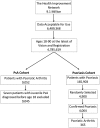Prevalence and treatment patterns of psoriatic arthritis in the UK
- PMID: 23221331
- PMCID: PMC3573270
- DOI: 10.1093/rheumatology/kes324
Prevalence and treatment patterns of psoriatic arthritis in the UK
Abstract
Objectives: The objectives of this study were to determine the prevalence of PsA in The Health Improvement Network (THIN), a large population-based medical records database in the UK, to examine factors associated with prevalent PsA among patients with psoriasis and to describe the use of DMARDs in patients with PsA.
Methods: Two cohorts were derived from THIN to examine the prevalence of PsA in a cross-sectional study among all patients aged 18-90 years and among a subcohort of 4900 psoriasis patients aged 45-65 years. Prescription codes were used to describe therapies after the diagnosis of PsA. Associations for prevalent PsA among psoriasis patients were assessed using logistic regression analysis.
Results: Among 4.8 million patients in THIN between the ages of 18 and 90 years, 9045 patients had at least one medical code for PsA, giving an overall prevalence of 0.19% (95% CI 0.19%, 0.19%). Of those patients, 45.9% with PsA have been prescribed DMARDs. Among the 4064 confirmed psoriasis patients, the prevalence of PsA was 8.6% (95% CI 7.7%, 9.5%). PsA was more prevalent among patients with severe psoriasis [odds ratio (OR) 3.34; 95% CI 2.40, 4.65], obesity (OR 1.77; 95% CI 1.30, 2.41) and duration of psoriasis for ≥10 years (OR 7.42; 95% CI 3.86, 14.25) in the fully adjusted model.
Conclusion: The prevalence of PsA in THIN is consistent with previous population-based estimates. Limitations include a definition of PsA based on a diagnostic code rather than Classification Criteria for Psoriatic Arthritis (CASPAR) criteria. Given the large population of PsA patients, THIN is an important resource for the study of PsA.
Figures


References
-
- Gladman DD, Shuckett R, Russell ML, Thorne JC, Schachter RK. Psoriatic arthritis—an analysis of 220 patients. Q J Med. 1987;238:127–41. - PubMed
-
- Gladman DD, Chandran V. Review of clinical registries for psoriatic arthritis: lessons learned? Value for the future? Curr Rheumatol Rep. 2011;13:346–52. - PubMed
-
- Eder L, Chandran V, Shen H, et al. Incidence of arthritis in a prospective cohort of psoriasis patients. Arthritis Care Res. 2011;63:619–22. - PubMed
Publication types
MeSH terms
Substances
Grants and funding
LinkOut - more resources
Full Text Sources
Medical
Research Materials
Miscellaneous

